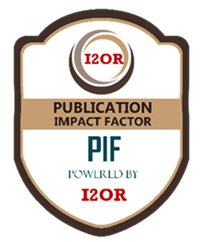Developing Models to Explain Point Spread of NCAA Women’s Division II Basketball Games
DOI:
https://doi.org/10.53555/nnms.v3i6.552Keywords:
Least Squares Regression, Logistic Regression, Basketball Tournament, In-Game StatisticsAbstract
A model is developed using in-game statistics to help explain the final point spread of a Women’s Division II Basketball Tournament game. A model is also developed to estimate the probability of a team winning the game given significant in-game statistics. Both of the models are verified based on a random sample of basketball games that were not used in the development of the models. The models were then used to predict the outcomes of the 63 games played in the 2015 NCAA Division II Women’s Basketball tournament replacing the actual in-game statistics with seasonal averages of the corresponding statistics. Results are given.
References
Abraham, Bovas, and Ledolter, Johannes (2006). Introduction to Regression Modeling. Belmont: Thomson Brooks/Cole, 2006. Print.
Barra, Allen (2014). Is March Madness a Sporting Event—or a Gambling Event? Retrieved from http://www.theatlantic.com/entertainment/archive/2014/03/is-march-madness-a-sporting-event-or-a-gambling-event/284545 on 12/8/2015.
Dirks, Kurt T. (2000). Trust in Leadership and Team Performance: Evidence from NCAA Basketball. Journal of Applied Psychology, 85(6): 1004-1012.
Kubatko, Justin; Oliver,,Dean; Pelton,Kevin; and Rosenbaum, Dan T. (2007). A Starting Point for Analyzing Basketball Statistics. Journal of Quantitative Analysis in Sports, 3(3): Article 1.
Magel, Rhonda, and Unruh, Samuel (2013). Determining Factors Influencing the Outcome of College Basketball Games. Open Journal of Statistics (http://www.scirp.org/journal/ojs).
NCAA. 2015. 2016 Division II Women’s Basketball Championship: Pre-Championship 2015-16 Manual. Retrieved from http://www.ncaa.org/sites/default/files/2015-16_DIIWBB_PreChamps_20151109.pdf on 12/8/2015.
NCAA. 2012 DII Women's Basketball Championship. Retrieved from http://fs.ncaa.org/Docs/stats/w_basketball_champs_records/2012/d2/html/confstat.htm on 12/9/2015.
NCAA. 2013 DII Women's Basketball Championship. Retrieved from
http://fs.ncaa.org/Docs/stats/w_basketball_champs_records/2013/d2/html/confstat.htm on 12/9/2015.
NCAA. 2014 DII Women's Basketball Championship. Retrieved from
http://fs.ncaa.org/Docs/stats/w_basketball_champs_records/2014/d2/html/confstat.htm on 12/9/2015.
NCAA. 2015 DII Women's Basketball Championship. Retrieved from
http://fs.ncaa.org/Docs/stats/w_basketball_champs_records/2015/d2/html/confstat.htm on 12/9/2015.
NCAA. About NCAA Division II. Retrieved from http://www.ncaa.org/about?division=d2 on12/8/2015.
NCAA. Championships. Retrieved from http://www.ncaa.org/about/what-we-do/championshipson 12/8/15.
Pomeroy, K. (2014) Pomeroy’s ratings. Available: http://www.kenpom.com
Sagarin, J. (2014). Basketball Statistics. Available: http://www.usatoday30.usatoday.com/sports/sagarin.htm.
Schwertman, Neil C.; McCready,Thomas A.; and Howard, Lesley (1991). Probability Models for the NCAA Regional Basketball Tournaments. The American Statistician, 45(1): 35-38.
Shen, Gang; Hua, Su;Zhang, Xiao; Mu, Yingfei;and Magel, Rhonda (2015). Predicting Results of March Madness Using the Probability Self-Consistent Method. International Journal of Sports Science, 2015, 5(4): 139-144.
Wang, Wenting, and Magel, Rhonda (2014). Predicting Winners of NCAA Women’s Basketball Tournament Games. International Journal of Sports Science, 2014, 4(5): 173-180.
West, B.T. (2006). A Simple and Flexible Rating Method for Predicting Success in the NCAA Basketball Tournament. Journal of Quantitative Analysis in Sports, 2, 3, p 3-8.
West, B.T. (2008). A Simple and Flexible Rating Method for Predicting Success in the NCAA Basketball Tournament: Updated Results from 2007. Journal of Quantitative Analysis in Sports, 4, 2, p 6-8.
Published
Issue
Section
License

This work is licensed under a Creative Commons Attribution-NonCommercial-NoDerivatives 4.0 International License.
You are free to:
- Share — copy and redistribute the material in any medium or format for any purpose, even commercially.
- Adapt — remix, transform, and build upon the material for any purpose, even commercially.
- The licensor cannot revoke these freedoms as long as you follow the license terms.
Under the following terms:
- Attribution — You must give appropriate credit , provide a link to the license, and indicate if changes were made . You may do so in any reasonable manner, but not in any way that suggests the licensor endorses you or your use.
- No additional restrictions — You may not apply legal terms or technological measures that legally restrict others from doing anything the license permits.
Notices:
You do not have to comply with the license for elements of the material in the public domain or where your use is permitted by an applicable exception or limitation .
No warranties are given. The license may not give you all of the permissions necessary for your intended use. For example, other rights such as publicity, privacy, or moral rights may limit how you use the material.




